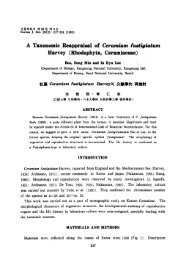A NEW BROWN ALGAL ORDER, ISHIGEALES (PHAEOPHYCEAE ...
A NEW BROWN ALGAL ORDER, ISHIGEALES (PHAEOPHYCEAE ...
A NEW BROWN ALGAL ORDER, ISHIGEALES (PHAEOPHYCEAE ...
You also want an ePaper? Increase the reach of your titles
YUMPU automatically turns print PDFs into web optimized ePapers that Google loves.
among the rbcL, psaA, and psbA data sets in the present<br />
study. This is a contrast to congruence among the same<br />
three genes in the ceramiaceous red algal tribe Griffithsieae<br />
(Yang and Boo 2004). However, the combined<br />
sequences of the three genes have more resolving<br />
power and clade support for all ordinal taxa including<br />
the three orders, the Laminariales not resolved in the<br />
psaA and psbA trees and the Dictyotales and Sphacelariales<br />
not supported in the psbA tree, than the sequences<br />
of individual gene. The individual and combined data<br />
sets are congruent in phylogenetic positions of the Ishigeaceae<br />
and the Ectocarpales within the Phaeophyceae<br />
investigated. It appears that incongruence among<br />
the three genes is probably attributed to unstable relationships<br />
among orders, which are a feature well<br />
known in phylogenetic reconstructions of the Phaeophyceae<br />
(Draisma et al. 2001, 2003, Rousseau et al.<br />
2001). Our studies show that statistically incongruent<br />
data can be combined for a better understanding of<br />
brown algal phylogeny, although the rbcL, psaA, and<br />
<strong>ISHIGEALES</strong> ORD. NOV. 929<br />
FIG. 2. ML tree for the Ishigeaceae<br />
and other phaeophyceaen algae<br />
estimated from the psaA sequence<br />
data (GTR þ G þ I model, –ln likelihood<br />
5 16551.60179; G 5 0.568987;<br />
I 5 0.492528; A–C 5 2.626896, A–G 5<br />
4.898248, A–T 5 0.072912, C–G 5<br />
3.757704, C–T 5 12.922112, G–T 5 1).<br />
The bootstrap values shown above the<br />
branches are from ML/MP methods<br />
and dashes indicate o50% support of<br />
bootstrap. Thick branches indicate<br />
Bayesian posterior probabilities 0.9.<br />
psbA genes possess different phylogenetic information.<br />
Our results indicate that the psaA and psbA genes, both<br />
being independent to each other (Morden and Sherwood<br />
2002), are useful for other brown algal phylogeny<br />
and have more resolution when combining with<br />
other molecular data such as the rbcL gene.<br />
In the present study, the Phaeophyceae are well resolved,<br />
having the Schizocladiophyceae as sister taxon<br />
in the rbcL and combined data sets, although the<br />
Tribophyceae was the sister to the Phaeophyceae in<br />
the psaA and psbA data sets. Based on trees of individual<br />
and combined data sets, the Phaeophyceae<br />
consist of two large groups. The ‘‘basal group’’ included<br />
the Choristocarpaceae, Ishigeaceae, Dictyotales,<br />
Sphacelariales, and Syringodermatales and the ‘‘crown’’<br />
contained the Ectocarpales, Fucales, Laminariales, and<br />
other many lineages. These two groups are also reflected<br />
in the trees of previous rbcL (Draisma et al. 2001,<br />
2003) and LSU þ partial SSU data sets (Rousseau et al.<br />
2001). However, because the interrelationships of the




